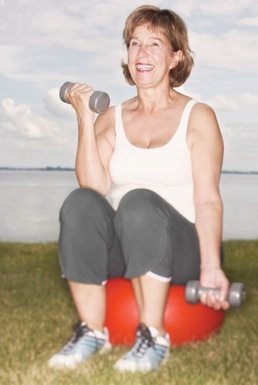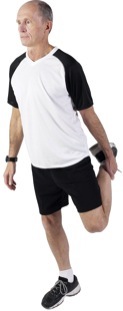-
Staying Well



Be Physically Active
Physical activity increases fitness. It helps build and maintain healthy bones, muscles, and joints. It helps manage weight and control blood pressure. It helps you look and feel better. It also lowers the risk for heart disease, colon cancer, and type 2 diabetes.
-
•Each week, adults should do at least 2 hours and 30 minutes of moderate-intensity (or 1 hour and 15 minutes of vigorous-intensity) physical activity. Additional physical activity may be needed to lose weight and prevent weight gain.
-
•Children and teens should do at least 60 minutes of physical activity every day.
Aerobic exercise uses large muscles of the lower body (legs, buttocks).
Strengthening exercises help build muscle.

Types of Exercise
-
•Aerobic Exercise. This type speeds your heart rate and breathing. It promotes cardiovascular fitness. Examples are walking briskly, swimming, jumping rope, and jogging.
Three Steps of Aerobic Exercises
-
1.Warm Up. Warm Up. Spend 5 to 10 minutes stretching or doing the aerobic activity at a slower pace.
-
2.Aerobic Activity. To be aerobic, the activity you choose should:
-
-Be steady and nonstop
-
-Last a minimum of 20 minutes. You can start out for shorter periods of time, many times a day. For example, start with 5 minutes, 4 times a day. Try to do more minutes each time.
-
-Allow you to speak without gasping for breath.
-
-Result in your target heart rate. This is 60 to 80% of your maximum heart rate. (See “Target Heart Rate Zone” below.)
-
3.Cool Down. Cool down slowly. Choose a slower pace of the activity you were doing. For example, if you were walking briskly, walk slowly. Or, stretch for about 5 minutes.
Strengthening Exercises
Do muscle-strengthening activities that involve all major muscle groups. Adults need to do these on 2 or more days a week; children and teens should do these at least 3 days a week.
Benefits of Strengthening Exercises
-
•They let your muscles work longer before they get tired. This is called endurance.
-
•They improve your bone density. This helps prevent osteoporosis and fractures.
Strengthening Exercise Guidelines
-
•Use weights or a stretch band. Try out different ones to find what’s right for you. For strengthening, you should be able to do at least 2 sets and repeat these 8 times. The weight is too heavy if you can’t. If you can easily do more than 3 sets, 12 times, use a heavier weight.
-
•Give muscles a day to rest in between workouts. If you work out every day, do the upper body one day; the lower body the next.
-
•Move slowly. Don’t jerk the weights up. Don’t drop them too fast.
-
•Keep your knees and elbows slightly bent.
-
•Breathe out when you are at the hardest part of the exercise. Breathe in when you return to the starting position. Don’t hold your breath.
-
•Work opposing muscles. For example, after you work the front of the arm (biceps), work the back of the arm (triceps).
-
•Talk to your doctor or a fitness consultant for a complete exercise program.
Stretching Exercises
These make your body more flexible. This helps to prevent injury during sports, exercise, and everyday activities. Do stretching exercises before and after every strengthening or aerobic workout.
Stretching Exercise Guidelines
-
•Try slow, relaxing stretches like those in yoga or tai chi.
-
•Try swimming. It builds flexibility.
-
•Stretch after exercise when muscles are warmed up. Stretch gradually.
-
•Don’t bounce. Don’t hold your breath. Exhale as stretching continues.
-
•Stretch every day, even if you don’t exercise.
-
•Don’t stretch areas where pain is felt.
Other Ways to Be Physically Active
-
•Recreation. Swim, golf, dance, etc.
-
•Active hobbies, such as working in the garden.
-
•Chores, such as washing windows, etc.
Physical Activity Advice
-
•Check with your doctor before starting any new vigorous exercise if you have a chronic health problem or if you are over age 40 (men) or 50 (women).
-
•Get physically active. Maintain or increase physical activity if you are already active. Stay active throughout your life.
-
•Choose activities that fit in with your daily routine.
-
•If muscles or joints start to hurt while you exercise, ease up.





Get more information from:
HealthyLearn® | www.HealthyLearn.com. Click on MedlinePlus®.
U.S. Department of Health & Human Services | www.health.gov/paguidelines



Copyright © 2009, American Institute for Preventive Medicine. All rights reserved.